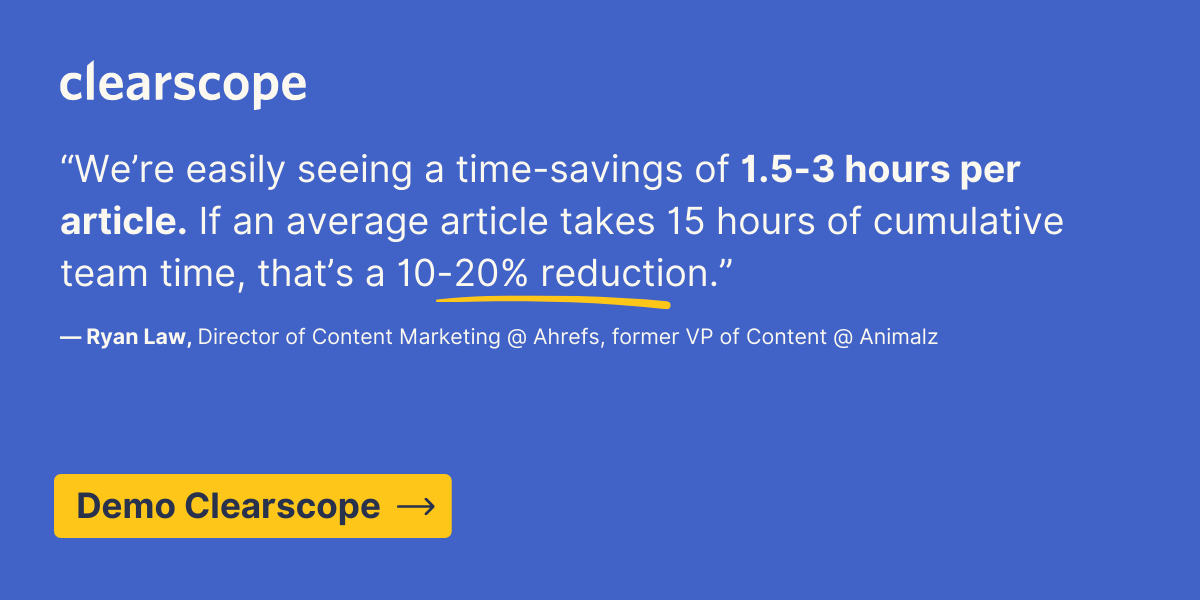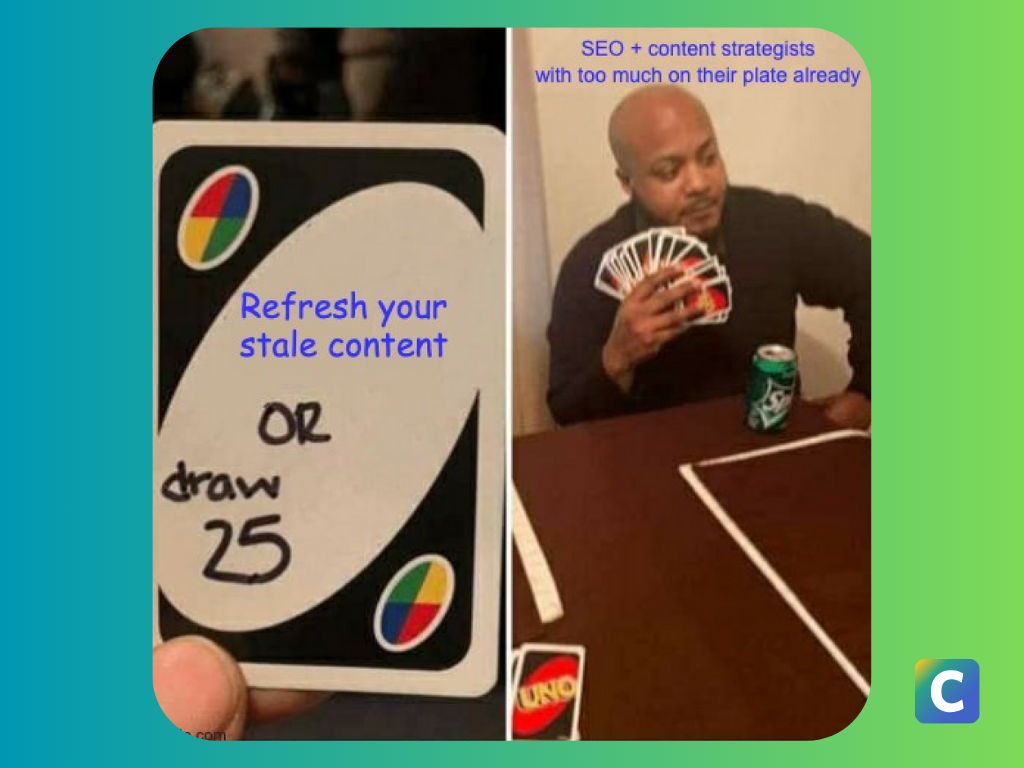What Is a Content Refresh and Why It Matters for SEO
Topic: Content Marketing
Published:
Written by: Bernard Huang
TL;DR: What is a Content Refresh?
A content refresh involves updating and optimizing existing website content, whether it’s a single page or a group of related pages in a topic.
This can include adding new content, removing outdated information, improving readability, updating metadata, and ensuring that the content aligns with current searcher intent.
It’s like giving your old web pages a fresh coat of paint to keep them relevant and engaging.
In this Clearscope webinar, Maeva Cifuentes addresses what a content refresh strategy is and the processes and systems you need in place to do refreshes successfully at scale.
Key Components of a Content Refresh
The key components of a content refresh can include:
Updating the text, images, and other media elements
Optimizing for new keywords
Fixing broken links
Ensuring all SEO elements, like meta descriptions, title tags, and alt text, are current
Adding internal links and backlinks that can significantly enhance the content’s value and improve the website’s performance.
Why Content Refreshes Matter for SEO
There are some vital reasons content refreshes should be part of your regular SEO practices.
They can:
Impact your search engine rankings and organic traffic
Provide opportunities to invest in user experience and readability
Rework pieces to better meet current user intent
Play a key part in a healthy content marketing and digital marketing strategy
Impact on Search Engine Rankings and Organic Traffic
Refreshing your content can significantly impact search engine rankings and organic search traffic.
Search engines, like Google and Bing, prioritize relevant content that is up-to-date.
By updating your content, you can improve your position on the search engine results pages (SERPs), potentially leading to increased visibility and more search traffic.
Enhancing User Experience and Readability
A well-executed content refresh enhances the user experience by improving readability and relevance.
This includes simplifying complex information, breaking up and restructuring text with headings and subheadings, and adding visual elements like infographics, videos, and screenshots.
Not only do these kinds of updates keep users engaged with your content, but they also can reduce bounce rates and improve conversion rates.
Relevance to User Intent
Keeping your content aligned with current search intent (ie, user intent) ensures it meets the needs of your target audience.
This involves regular keyword research and optimization, focusing on relevant keywords that match what users are currently searching for.
Analyzing features like the "People Also Ask" snippets can provide valuable insights into common pain points and questions.
LEARN MORE: How to find your goldilocks keywords with search intent analysis
Role in Content Marketing Strategy and Digital Marketing
A content refresh is a crucial part of any content marketing strategy.
It helps maintain the relevance and quality of your content, ensuring it continues to attract and engage users.
This supports broader digital marketing efforts by keeping your content competitive, shareable, and valuable over time.
For example, companies like HubSpot are not only invest in new content creation, but they also utilize regular content updates to stay on the first page of search results for high-volume search queries.
How Do Content Refreshes Work?
Here’s what you need to do for a content refresh project:
1. Identify outdated content and areas of content decay
2. Audit performance of existing content and areas for improvement
3. Update the content of the page(s)
Identifying Outdated Content and Pages With Content Decay
The first step in a content refresh is identifying outdated content and addressing content decay.
Content decay refers to the gradual decline in the performance of your content over time due to factors like changing search algorithms, shifts in user interest, or new competitors entering the scene.
Clearscope has a reporting feature that easily indicates what pages in your content inventory have decayed over time. Learn more about Content Decay here.

Content Audit: Assessing Existing Content and Metrics
A thorough content audit is essential for understanding the state of your current content.
This involves assessing various metrics, such as traffic, engagement, conversions, and rankings, to determine which pieces of content need updating.
Competitive analysis can also provide insights into how your content stacks up against others in your industry.
Tools like Clearscope, Google Analytics, Google Search Console, Ahrefs, and SEMrush are invaluable for this process.
These tools help you analyze your content’s performance, identify target keywords, and discover opportunities for optimization to keep your content fresh.

We know you have a lot on your plate already. Clearscope simplifies content refreshes and performance monitoring for you. (You're welcome!)
Updating and Optimizing Content
Updating content involves several steps:
Add new and relevant keywords
Improve meta data if needed
Enhance or update visuals
Use strategies for improving engagement
Add New Keywords and Relevant Keywords
Incorporate new and relevant keywords into the content to improve its visibility for current search queries.
Improve Metadata: Meta Descriptions, Title Tags, Headers, and Alt Text
Ensure all metadata is optimized with relevant keywords to improve click-through rates (CTR) from the SERPs.
Enhance Content with Infographics, Screenshots, and Fresh Content
Adding new visuals and updating the text helps keep the content engaging and relevant.
Consider incorporating in-depth information, case studies, or new data, which can provide comprehensive coverage of the topic.
Strategies for Improving CTR and Bounce Rate
Enhancing headlines, optimizing word count, using compelling CTAs (calls to action), and ensuring a mobile-friendly design—like well-spaced paragraphs and bullet points—can help improve CTR and reduce bounce rates.
For a step-by-step guide on content reoptimization (aka content refreshes) and current best practices, see Maeva Cifuentes' Clearscope Webinar: How to make the most of your content reoptimization strategy.
Best Practices for Content Refresh
1. Prioritize high-impact pages
2. Monitor your content’s performance and results
3. Incorporate and plan for content refreshes in your overall marketing strategy
Prioritizing High-Impact Pages: Landing Pages, Evergreen Content, and Pillar Content
Focus on high-impact pages like landing pages, evergreen content, and pillar content, which are central to your SEO strategy and often draw the most traffic.
These pages often contain high-value information that users consistently seek, making them prime candidates for updates.
Monitoring Performance and Measuring Results
Track conversions, user engagement, keyword rankings, and website traffic: Use tools like Google Analytics and Google Search Console to track conversions, user engagement, and website traffic post-refresh.
Analyze data with SEO tools: Regularly analyze performance data with tools like Clearscope, Google Search Console, Ahrefs, SEMrush to assess the effectiveness of your content refresh and make necessary adjustments. Keep an eye on search volume and ranking factors to stay ahead of trends. (Clearscope makes this easy.)
Refresh Strategy: Planning and Implementing
Use an editorial calendar for content updates.
An editorial calendar helps plan and organize your work, ensuring consistent and timely refreshes. This can be particularly useful for SaaS companies that need to regularly update technical and industry-specific content.
And don’t forget about those older URLs.
Set up redirects for removed or consolidated pages Using redirects for any removed or consolidated pages can maintain link equity and avoid crawling errors.
Additional Considerations for a Successful Content Refresh
If you’ve made it this far, it’s likely we don’t have to convince you that refreshing old content is a powerful SEO strategy that can breathe new life into your website.
By keeping content updated, relevant, and optimized, you can maintain strong search engine rankings, attract more organic traffic, and ultimately achieve your content marketing goals.
Plus, it’s often less time-consuming than creating new content from scratch!
Here are a few more things you need to keep in mind when planning your content refreshes:
The Role of Social Media in Promoting Refreshed Content
Promote your refreshed content on social media to increase visibility and drive traffic. Engaging with influencers can also amplify your reach and credibility.
Avoiding Pitfalls: Common Mistakes and How to Avoid Them
Common refresh mistakes include over-optimizing, not setting up proper redirects, and neglecting to refresh for user experience or current search intent.
Avoid these by following SEO best practices and maintaining a user-first approach.
Future-Proofing Content: Strategies for Long-Term Success
To future-proof your content, focus on high-quality, timeless topics, and keep updating content regularly based on performance data, new perspectives, and market trends.
This approach ensures that your content remains relevant and continues to drive search traffic.
FAQs About Content Refreshes and SEO Performance
Does updating older content improve SEO performance?
Yes, updating older content can significantly improve SEO performance by making it more relevant to current user queries and search algorithms.
What Types of Content Benefit Most from a Refresh?
Evergreen content, blog posts, and landing pages benefit the most from a refresh, as they often attract the most traffic and need to remain relevant over time.
How Often Should Content Be Refreshed?
Content should be refreshed as often as needed, based on changes in search intent, keyword trends, and content performance metrics.
How to Determine if a Content Refresh Is Successful?
Success can be measured by improvements in rankings, traffic, engagement, and conversions.
What Are the Signs of Content Decay?
Signs of content decay include a decline in traffic, lower engagement rates, and a drop in rankings for target keywords.
Additional Resources and Citations
1. Quality rater guidelines: E-A-T gets an extra E for Experience from the Google Search Central Blog
2. What creators should know about Google's helpful content update from the Google Search Central Blog
What Is Content Decay and Why It Matters for SEO
Discover what content decay is and why it matters for SEO. Understand its impact and learn best practices to combat it for sustained website health and performance.
Read moreSEO Content Checker | Clearscope Drafts & Content Inventory
Clearscope offers real-time SEO drafts and a Content Inventory dashboard to check SEO scores for new and existing content. See how our tool works.
Read moreWhy Search Intent Optimization Beats Keyword Optimization
Optimizing for search intent vs. SEO keywords: Which is better? Explore the difference between keyword and intent-based SEO strategies.
Read more